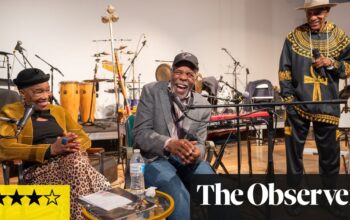M
Many jazz musicians aspire to fulfill the Big Band Dream, which involves leading a group of 12 to 20 members. This includes a rhythm section (typically consisting of piano, bass, drums, and occasionally guitar), as well as trombones, trumpets, and woodwinds. When these instruments come together, they create a powerful and impressive sound. Assembling a big band or jazz orchestra is no small feat and requires a great deal of ambition.
US saxophonist Steve Lehman expresses his enthusiasm for the format of working with a large number of instruments, as it presents a challenge and is a source of inspiration. He recently teamed up with France’s Orchestre National de Jazz, consisting of 17 members, to produce the innovative album Ex Machina, which seamlessly blends traditional acoustic sounds with modern, computer-generated noise.
There are other contemporary composer-improvisers, besides Los Angeles-based Lehman, who are creating impressive music using a large ensemble. Some of his colleagues, such as Henry Threadgill, Maria Schneider, and John Hollenbeck, have a daring and clever approach to utilizing this type of group. Dafnis Prieto, a Cuban American, and Darcy James Argue and Daniel Hersog, both from Canada, also experiment with big band arrangements. Mats Gustafsson, from Sweden, leads the appropriately named Fire! Orchestra. Additionally, there are established ensembles that have achieved a seminal status. The Sun Ra Arkestra has been spreading its cosmic vision and stunning costumes for almost seven decades, while Jazz Jamaica, led by Gary Crosby, creates a massive and danceable sound rooted in reggae and ska.
Large ensembles continue to hold an important place in the world of jazz, transcending cultural boundaries. They are particularly appealing to innovative composers due to their diverse range of harmonies. In the hands of Lehman, these harmonies are further enhanced through the use of cutting-edge technology, blending tradition with modernity. Lehman describes Ex Machina as a place where various voices and colors come together in intricate detail, with electronic elements adding depth to the overall sound. In a big band setting, the focus shifts to a collective effort, showcasing the talents of individual players.

Another outstanding 2023 orchestral album is Kemet (The Black Land) by USAmerican trombonist-composer Javier Nero. Featuring the excellent vocalist Christie Dashiell, the music, which is based on a strong Afrocentric premise, shows how engrossing the blues can be in a sophisticated, at times densely layered, setting. “[A big band] allows my music to reach the highest and lowest extremes dynamically,” says Nero, “and also allows me to expand the compositions in ways that would be too demanding or challenging in a smaller group setting.”
The origin of the big band can be traced back to the early 1900s when African American leaders such as Will Marion Cook and James Reese Europe formed syncopated orchestras. By the 1930s, popular bandleaders like Count Basie, Benny Goodman, and Duke Ellington turned big bands into a profitable industry. The image of fifteen musicians dressed in stylish suits performing in crowded dance halls became synonymous with the “swing” era. However, in the mid-40s, smaller groups like quartets and quintets gained popularity, thanks to Dizzy Gillespie and Charlie Parker’s bebop sound. Big bands were also expensive to maintain, a challenge that still exists today.
Lehman expresses with a heavy exhale that the financial aspect is extremely burdensome. Maintaining a large band is challenging, ensuring proper treatment for all members, and securing enough funds for recording can be a struggle.

Nero concurs. “In addition to composing and arranging all of the music, overseeing all printing and booking all of the musicians, those musicians must also be willing to accept lower pay in order to be involved,” he explains. “Many venues do not allocate extra funds to compensate an 18-member jazz orchestra more than a quartet, so it typically results in dividing the same pay among more people. I have been lucky to find musicians who are passionate enough about playing that they are willing to participate despite the lower compensation.”
Ignore the newsletter advertisement.
after newsletter promotion
Despite facing challenges, the large musical group has always persevered. It often acts as a main source from which smaller groups or projects emerge. For almost ten years, British trumpeter Mark Kavuma has been leading a band called the Banger Factory, which can have anywhere from 15 members to a smaller group of six, five, or even just two for specific endeavors. According to Kavuma, this model of switching between big bands and smaller groups is becoming more common. Additionally, having a consistent sound is possible due to the creative connections among the members. Even though the small and large groups may seem different, there is a strong sense of community within the band.
Nero appreciates the camaraderie that comes with being part of a big band, even if it does not necessarily represent a democratic structure. For Nero, the most attractive aspect of a big band is the opportunity for musical collaboration. He believes that incorporating big band music into education is beneficial because it teaches musicians the importance of teamwork and encourages socialization and communication among students. In Nero’s opinion, a big band can serve as a miniature representation of societal values in the Western world. When functioning effectively, everyone involved feels a sense of importance and takes pride in the success of others.
Source: theguardian.com


